How to unblock a dishwasher
Not only do our dishwashers save us the hassle of washing up piles of dirty dishes and cutlery, but they are also more environmentally friendly than cleaning the dishes by hand, so it is no surprise that it is very frustrating when they’re out of use due to a drainage problem. Continue reading to find out how to unblock a dishwasher and what you can do to help prevent future blockages.
Last updated - 27/10/2022
Estimated reading time - 8 minutes
How will I know if my dishwasher is blocked?
Here are some tell-tale signs that your dishwasher is blocked:
- There is standing water at the bottom of your dishwasher
- The dishwasher water is backing up into the kitchen sink
- Your dishwasher is making gurgling noises
- Your dishes are still dirty after a wash cyclr
- Your dishwasher smells
How to unblock a dishwasher: Unclog the filter and sump
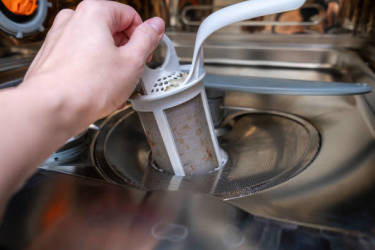
When your dishwasher rinses and cleans dirty dishes and cutlery, bits of food and other debris that get washed off end up in the dishwasher filter. The filter stores it so that it doesn’t end up on the cleaned dishes and so that it doesn’t clog the drain.
The filter is inserted into the sump assembly. The sump helps to control the flow of water into the drain pump. Pieces of food that manage to get past the filter will end up in the sump before they go down the drain.
If your dishwasher is blocked, this should be the first place you check to see if it is causing the blockage.
Follow these steps to unclog the filter and sump:
- Turn off the dishwasher.
- Remove the dishwasher baskets.
- Locate the dishwasher filter. You can find the filter at the bottom of your dishwasher.
- Remove the filter. How to remove your dishwasher's filter will depend on the make and model, but you will either be able to just pull it out or you may have to twist to unlock it first, then pull it out.
- Rinse the filter. Rinse the filter under a tap with warm water at high pressure. This will help dislodge some of the food particles stuck in the filter’s mesh.
- Clean the filter. Using an old toothbrush or sponge, gently scrub any debris, grease, or limescale off the filter. Do not scrub too hard as you may tear the filter mesh.
- Clear the sump. It’s not unusual for there to be some standing water at the bottom of the sump, but a large volume of standing water suggests there is a blockage in the system. If there is a lot of water in the sump, use a sponge to soak up the water and squeeze it out in the sink.
- Conduct a visual inspection of the sump. Remove any clear signs of obstructions. Be careful as it is not uncommon to find broken bits of glass in the sump.
- Reinsert the filter. Now that the filter is cleaned, put it back in the dishwasher and lock it back into place.

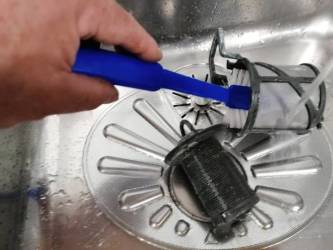
How to unblock a dishwasher: Unblock the dishwasher drain
A blocked dishwasher drain will mean that wastewater will not be able to drain out of the appliance.
Follow these steps to unblock your dishwasher’s drain:
- Turn off the dishwasher.
- Turn off the water supply. You can do this by using the main stopcock (also known as a shut-off valve).
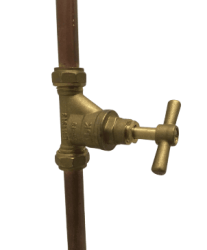
Water shut-off valve
The most common place for the main stopcock is under the kitchen sink, but if yours isn’t located there, then it might be in your utility room, bathroom, or a cupboard underneath the stairs. - Inspect the drain hose. The dishwasher drain hose is ribbed and is usually white or transparent. It is connected to the dishwasher pump and to a pipe under the kitchen sink.
If you have a freestanding dishwasher, pull it away from the wall and check that the dishwasher drain hose hasn’t been squashed or kinked. A kink in the drain hose could restrict wastewater draining out of the dishwasher and cause it to back up into the main compartment. Straighten out any kinks you may notice along the drain hose.
If you have an integrated dishwasher, it may be difficult to access the back of the dishwasher, but as the dishwasher is fixed in place, it is unlikely that the drain hose has been squashed.
If there weren't any kinks along the drain hose, or you have straightened them out and the dishwasher is still blocked, then you will need to drain the dishwasher manually. - Locate the drain hose connection. At the bottom of the dishwasher is a kick plate. This is a panel that allows access to some external components of the dishwasher. You can remove the kick panel by hand, or in some cases, you will need to unscrew it before it can be removed.
Once you have removed the kick plate, you will be able to access the end of the drain hose that is connected to your dishwasher’s drain pump. - Disconnect the drain hose. Grab a shallow container or tray and some towels and put them underneath where the drain hose connects to the drain pump. When you are ready to drain the dishwasher and the hose, unclamp the hose from the pump.
- Remove the drain hose. Once water has stopped flowing from the hose and/or the dishwasher, you should remove the hose and clear it of any obstructions. To do this, you will need to disconnect the other end.
The other end of the drain hose will be connected to the U-bend underneath the kitchen sink. Unclamp the dishwasher drain hose from the U-bend and remove the hose. - Unblock the drain hose. Take the hose outside and pour some warm water through it to clear out any blockages. If possible, use a garden hose at high pressure to remove any blockages that may be inside the hose.
- Reattach the drain hose. Once you have cleared the drain hose of any obstructions, reattach the hose at both ends and close the panel.
- Turn the water and power supply back on. You can now turn the water supply and the dishwasher back on. You should run a short cycle to ensure there are no leaks and that wastewater is draining as it should.
How to unblock a dishwasher: Unblock the dishwasher spray arms
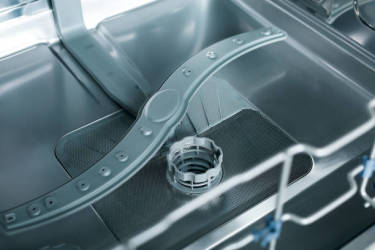
Dishwasher spray arms rotate and spray hot water inside the dishwasher to clean the dishes. Water gets sprayed through a number of small holes along the spray arm. Over time, tiny bits of food or debris may get clogged in the small holes and block the spray arm from squirting out water.
Blocked spray arms won’t cause dishwasher drainage problems, but they will stop it from cleaning your dishes properly.
If you have noticed that your dishes aren’t thoroughly cleaned, a blocked spray arm may be the reason.
Follow these steps to unblock your dishwasher’s spray arms:
- Turn off the dishwasher.
- Remove the dishwasher baskets.
- Remove the spray arms. The bottom spray arm can normally just be pulled out, whereas the upper spray will need to be unscrewed with a screwdriver.
- Unclog the spray holes. Use a toothpick to poke the spray holes in the arms to dislodge anything that may be clogging them.
- Clean the spray arms. Run the spray arms under some warm water to remove any scum and debris. You can use some washing up liquid and an old toothbrush or a sponge to clean them. Make sure you rinse off all the washing up liquid, because if any washing up liquid ends up in your dishwasher, it could cause a buildup of bubbles and suds, which could damage the dishwasher.
- Reattach the spray arms.
How to unblock a dishwasher: Replace faulty dishwasher pump
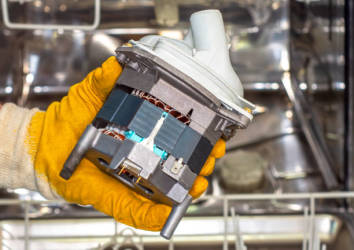
If you have taken the steps outlined in this article and your dishwasher is still blocked, you may have a deeper issue such as a faulty pump. During a wash cycle, the pump directs water towards the spray arms. During the drain cycle, the pump directs wastewater to the drain. If the pump is faulty or damaged, water will not be directed to the drain and will just sit at the bottom of the dishwasher.
Diagnosing and replacing a damaged pump is not a DIY kind of job, you will need to call an appliance engineer to replace a damaged pump.
If it is not a faulty pump that is preventing a dishwasher from draining, an appliance engineer will be able to find out what the problem is and will be able to choose the best course of action to unblock the dishwasher.
Let us fix your dishwasher.
At Smart Plan we have thousands of engineers up and down the country who are ready to fix your issue. We guarantee an engineer to your property within 48 hours.
How to prevent a blocked dishwasher

- Clear your dishes properly before putting them in the dishwasher. Scrape large pieces of food off your dishes, pots, and cutlery before putting them in the dishwasher. You don’t need to rinse every little piece off your dishes before you put them in the dishwasher, as the dishwasher and dishwashing detergent are capable of cleaning tough food stains, but larger pieces of food could end up clogging the filter and could prevent it from draining.
- Empty and clean the filter once a week. Use a soft toothbrush or sponge and some warm water to clean the filter. After you have cleaned it, make sure that you insert it and lock it back into place correctly, as the main way food manages to get into the sump is because the filter hasn’t been locked into place properly.
- Deep clean the dishwasher once a month. Over time, scum, grease, limescale, and food particles will buildup around the inside of your dishwasher. Cleaning your dishwasher regularly will prevent these obstructions from finding their way into areas of the dishwasher and potentially causing a blockage.
You can clean your dishwasher with some white vinegar and baking soda. White vinegar and baking soda are great at breaking up soap, dirt, and scum buildup, and also help wash away bad odours inside the dishwasher.
Follow these steps to clean your dishwasher:
- Empty the dishwasher and fill a dishwasher-safe bowl with two cups of white vinegar and place it on the top rack.
- Sprinkle a cup of baking soda around the bottom of the dishwasher.
- Without adding any detergents, run a hot cycle.
- Once the cycle is complete, wipe the interior of the dishwasher dry.

Avoid unexpected costs.
With a Smart Plan cover policy, you can rest easy knowing if there's an issue with your dishwasher, we'll usually have you back up and running within 48 hours.

